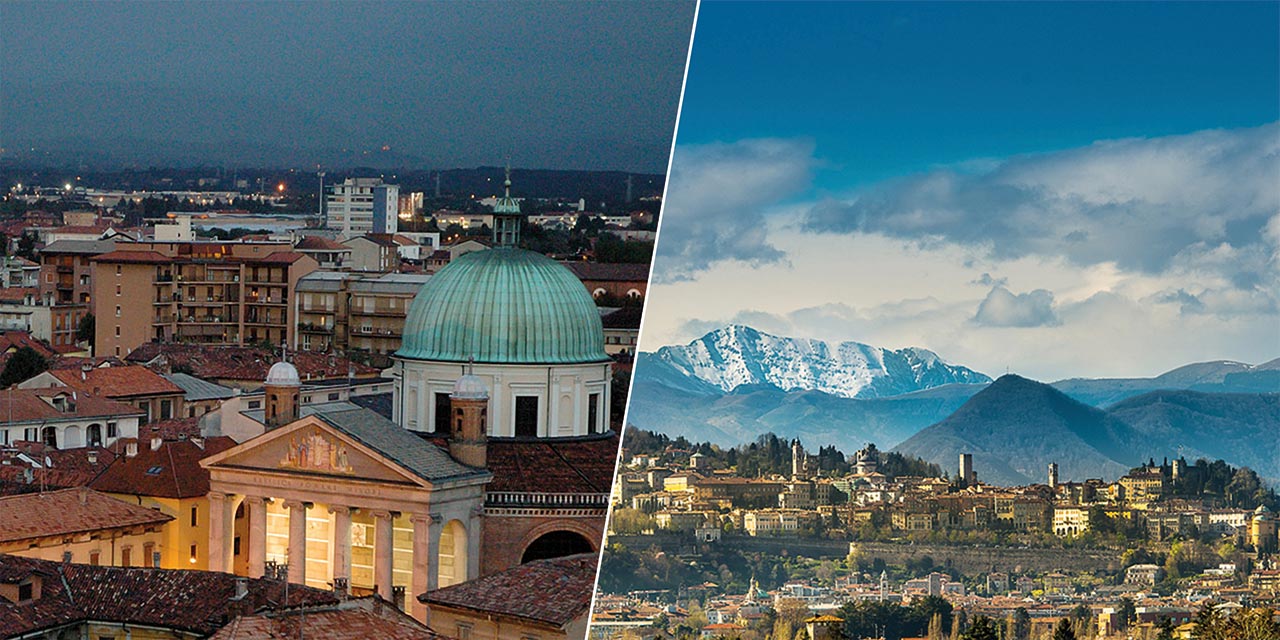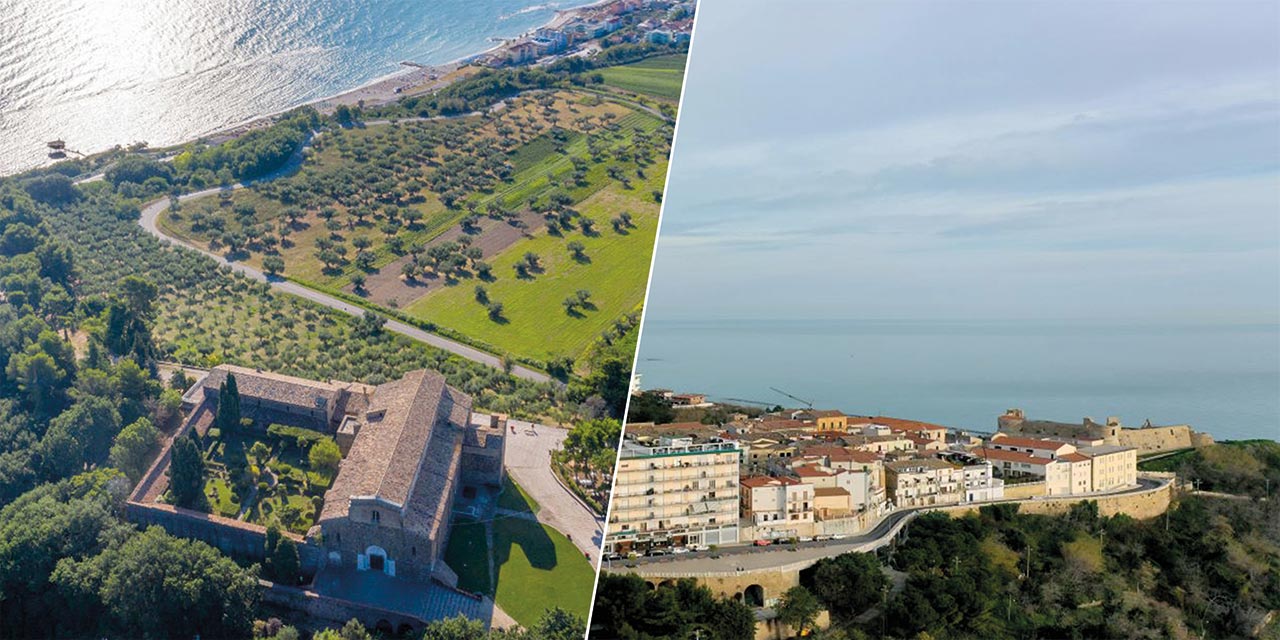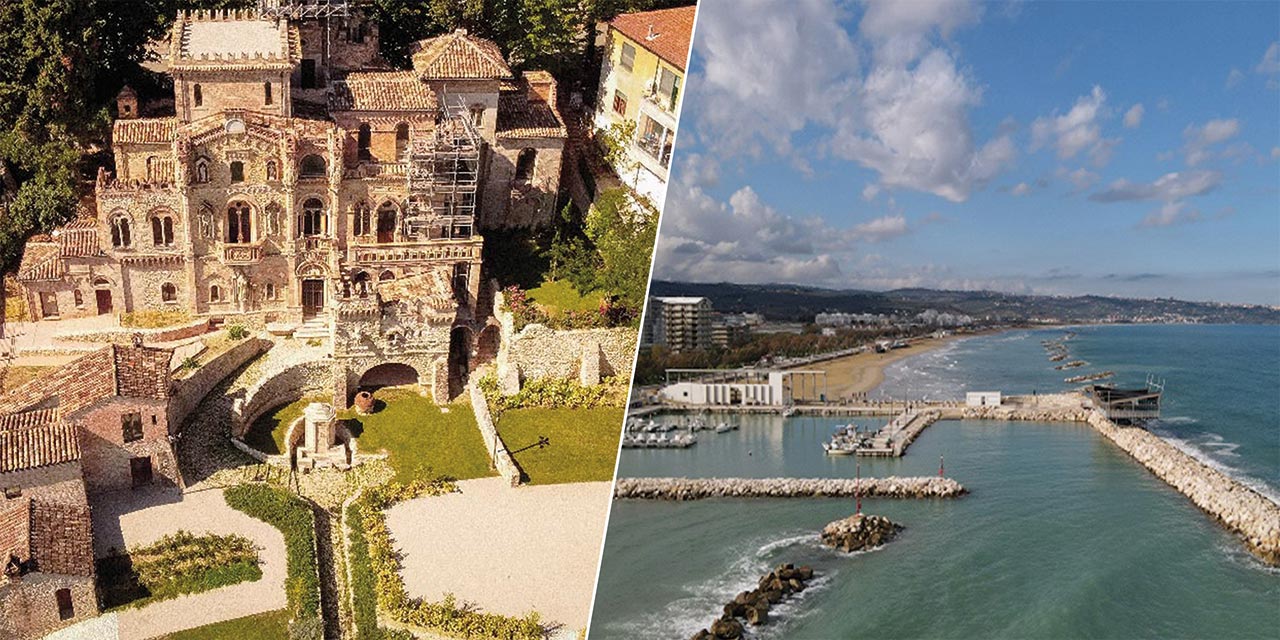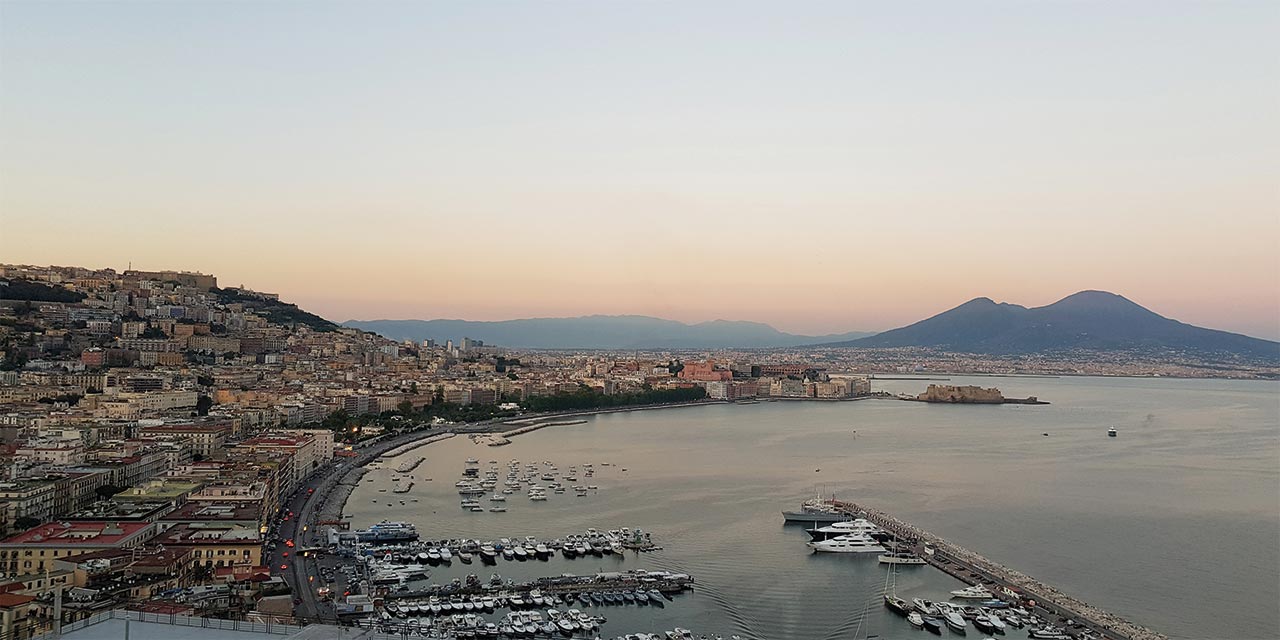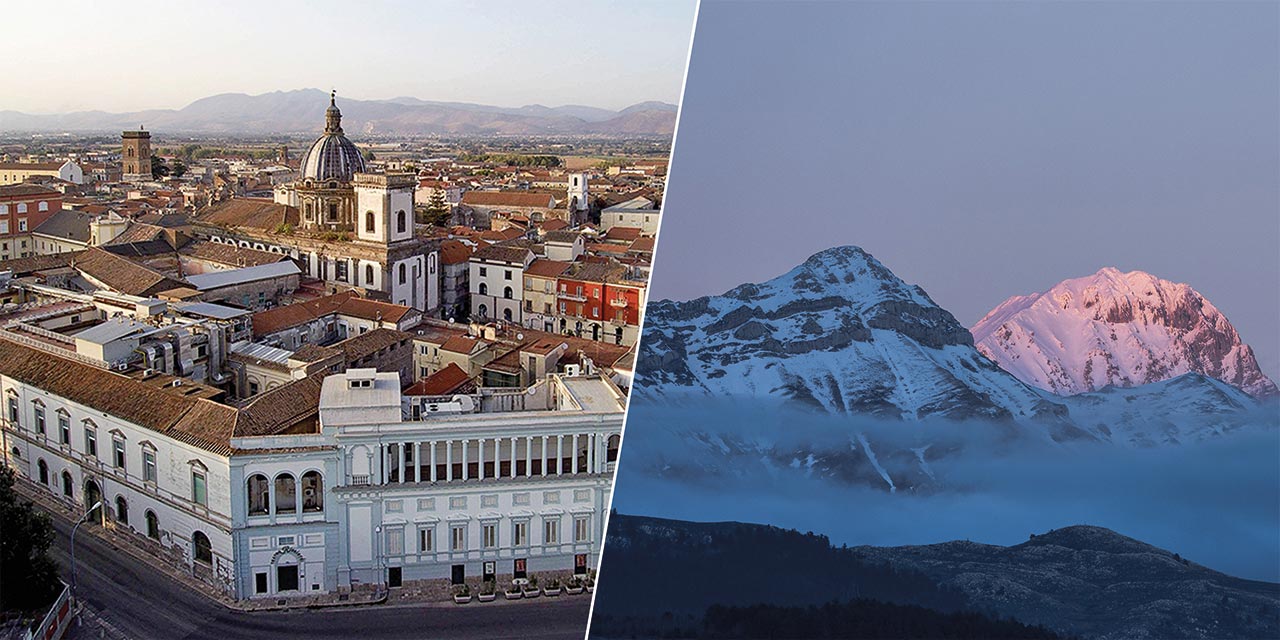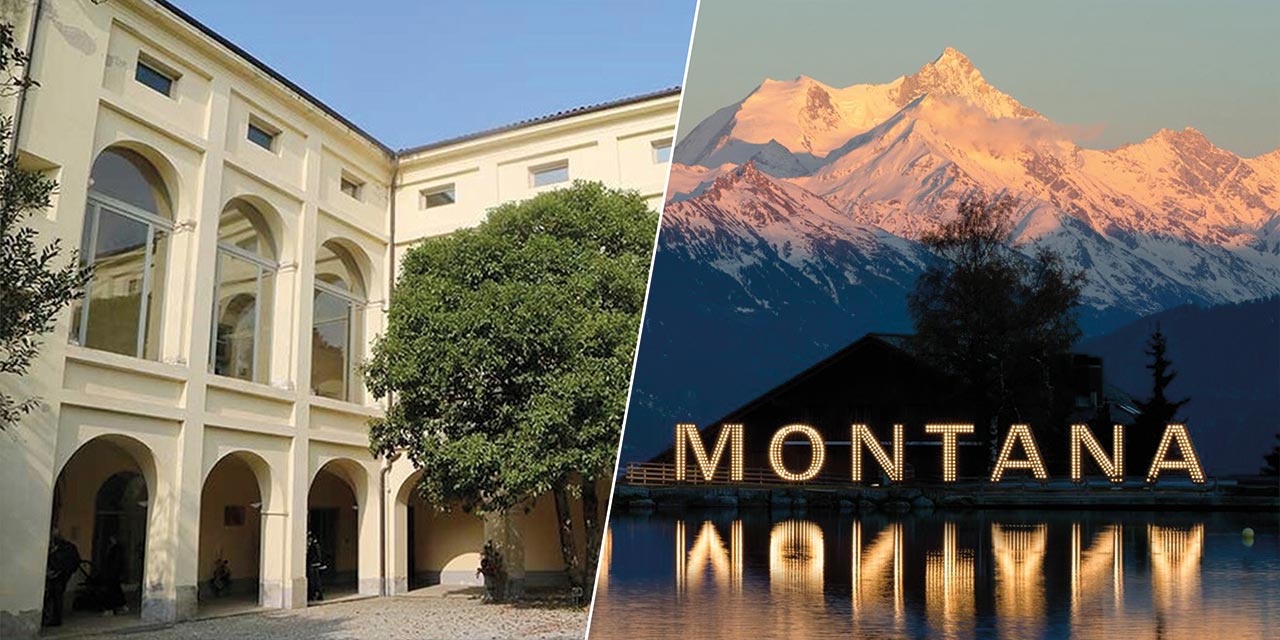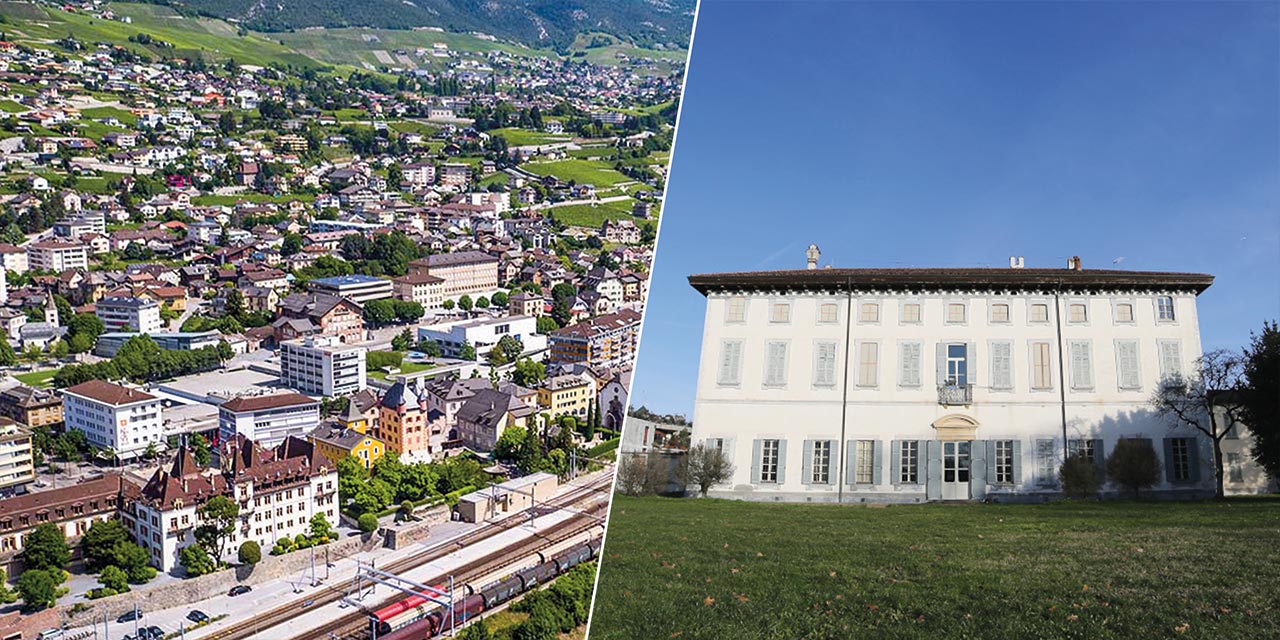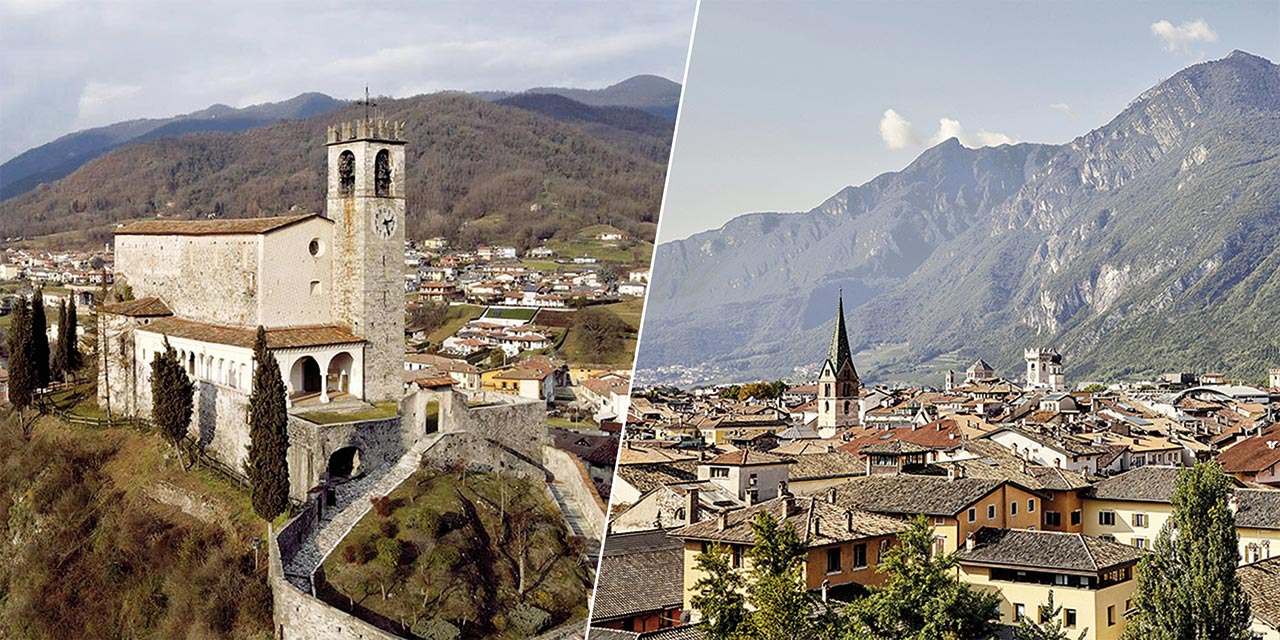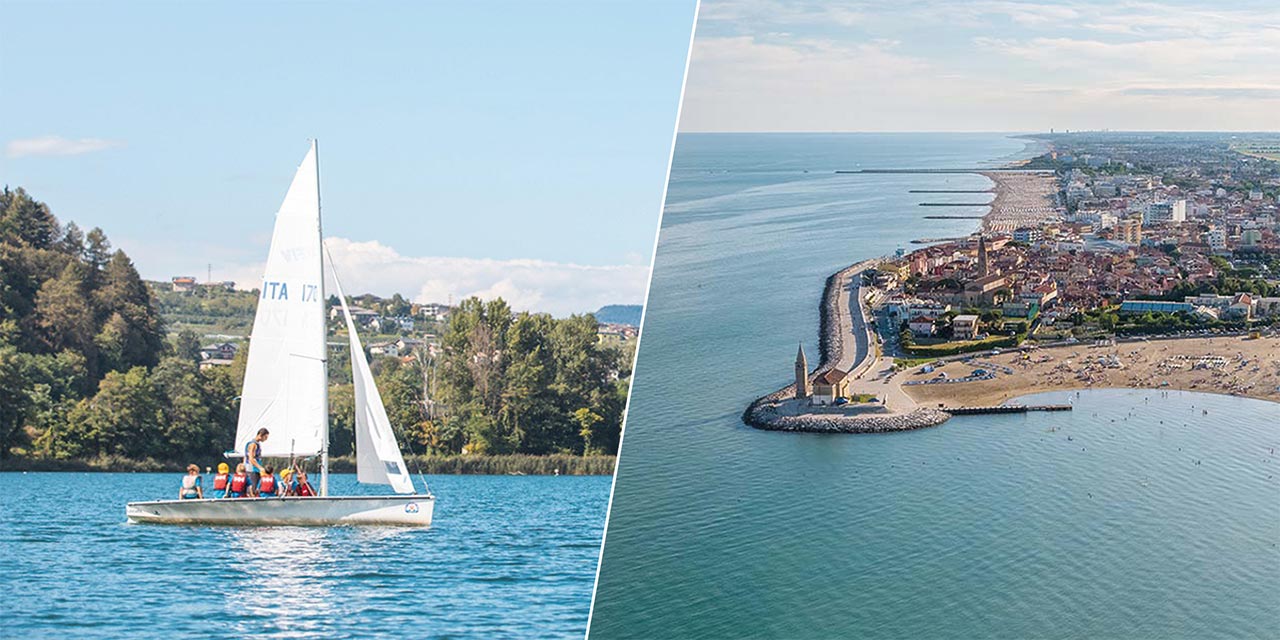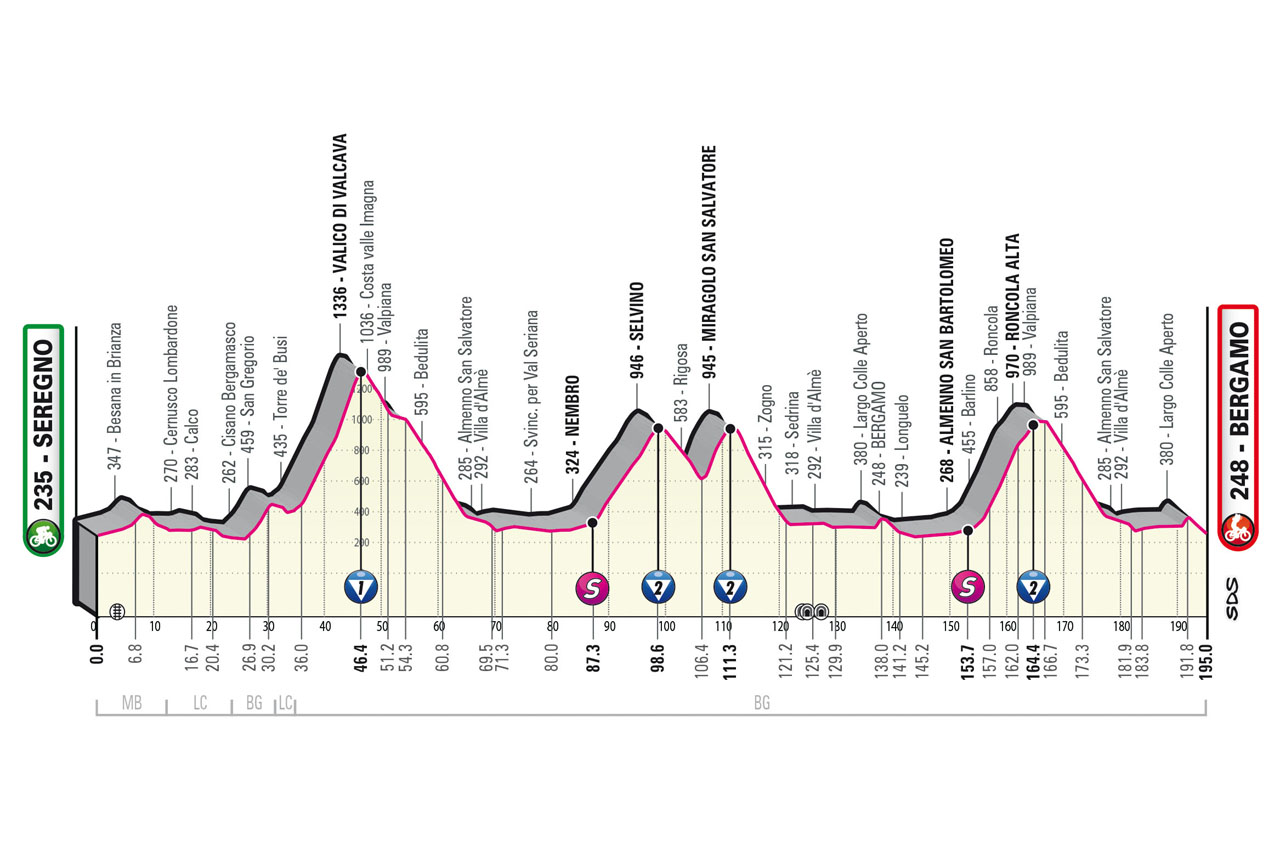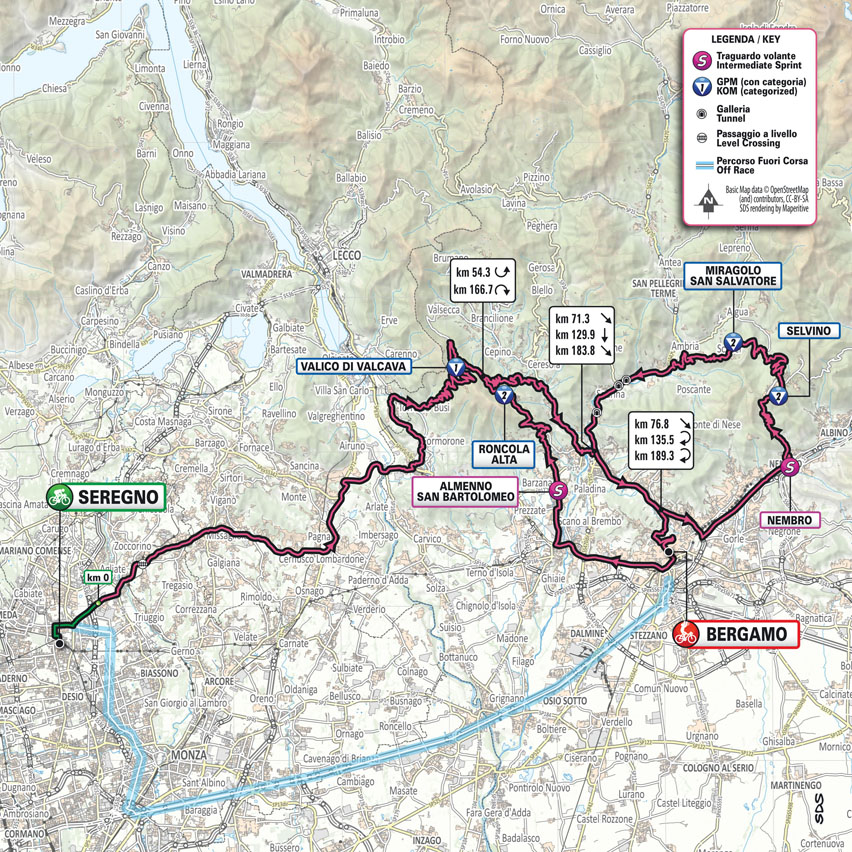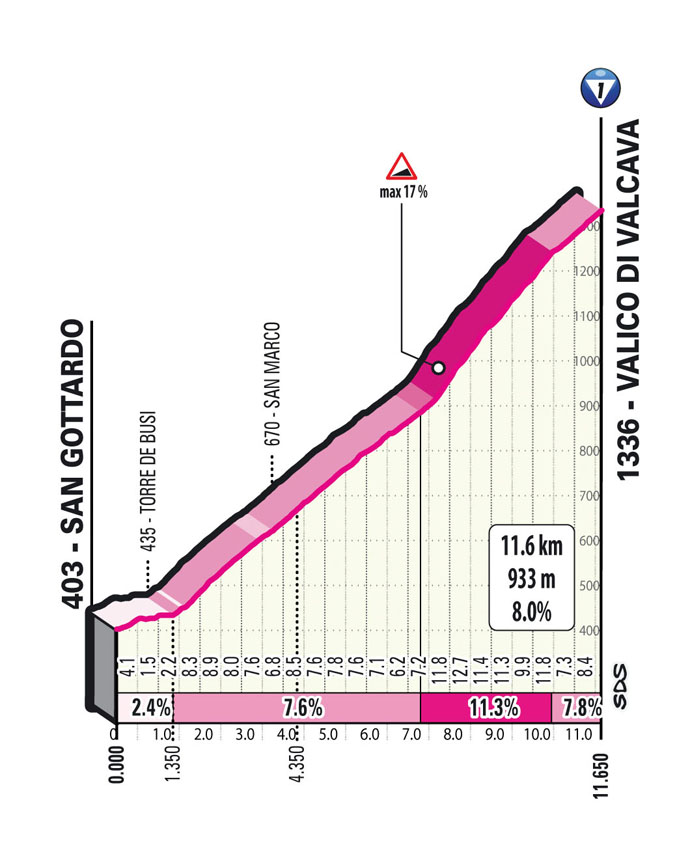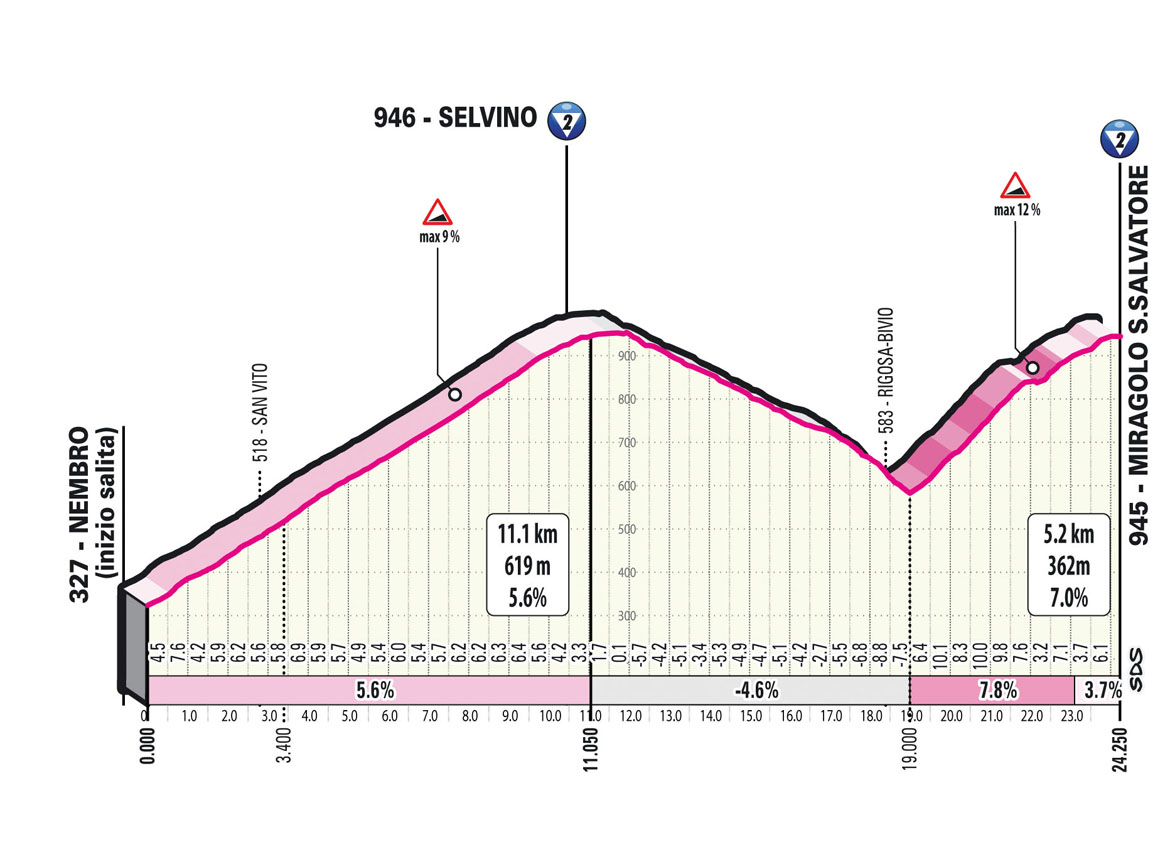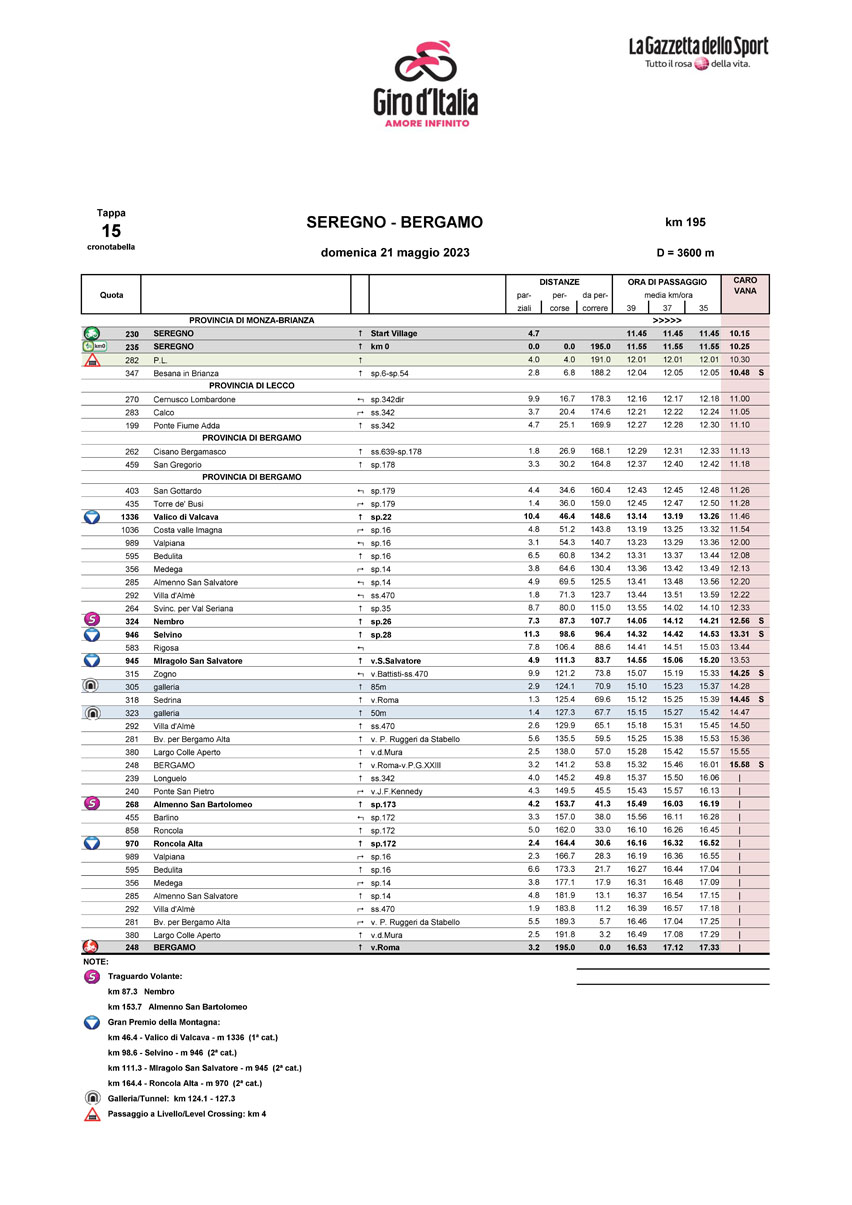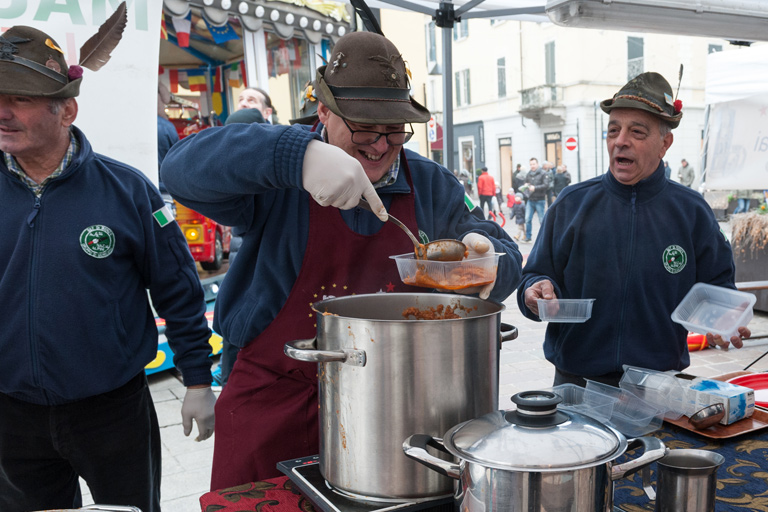altimetria
planimetria
info tecniche
This will be an ‘urban’ mountain stage. The Valico di Valcava, Selvino (‘traditional’ side), Miragolo San Salvatore and Valpiana (Roncola) ascents are linked with nearly no pause for breath. The route completes two loops and passes over the finish before taking in the last loop. The roads are wavy and curving, narrow but well surfaced. Down from the last climb (Valpiana), the following 9 kilometres (the only flat stretch of the race finale) serve as an approach to the city. The route then passes through Città Alta, heading for the finish.
Final kilometres
Over the final kilometres, the route runs across the upper city (Bergamo Alta), climbing up to reach Porta Garibaldi and then Largo Aperto (covering 200 metres on pebble paving). In the first sector, gradients never fall below 10% (with a maximum of 12%). Along the descent, the roadway is wide and the surface is smooth. With 1,800 m to the finish, a sharp bend and a sector on narrowed roadway lead through Porta Sant’Agostino. The road takes a wide bend to the left after the flamme rouge, leading to the finish line. The home stretch (800 m long, on 8 m wide asphalt road) runs initially downwards and levels out afterwards.
partenza / arrivo
dettaglio salite
ultimi km
crono tabella
info turistiche
Città di:
Seregno
Overview
Located along the route that from Milan leads to Como lake and Switzerland, at the intersection of one of the roads that leads east to the Lambro river, Seregno owes its characteristic features to this crossroads position. Historically, in fact, the village had developed thanks to the services that are connected to a place where people meet and develop commercial interests.
Today Seregno has more than 45,000 inhabitants and, despite being in a very dense urban area such as the Province of Monza and Brianza and with many large-sized urban cities, it maintains the peculiar and lively traits of a city that thrives on commerce, services for people and businesses. An industrious reality of Brianza, which however it is also a pole of attraction for leisure. A city that guarantees its inhabitants high standards of services in an urban context that is still “peolple-oriented”.
Food
Brianza cuisine has many common traits with that of Milan, even though overall it is declined with less rich raw materials and is less open to external influences. The most characteristic dishes and products respond to the need to optimize the yield of raw materials and to dedicate not excessive time to food (intended as preparation and as consumption).
Hence the most characteristic dishes are dips, made with cheap ingredients (for example cuts of meat of lesser value) and, above all, the results of a quick preparation (which does not mean ready in a short time: the preparation often requires a long cooking, which takes place on the stove lit to heat the house).
The sauce retains all the nutritional properties and all the flavour. These are dishes with a very strong taste, such as the “Cassoeula” (the name, strictly in dialect, does not have a convincing counterpart in Italian). It is a particular stew of pork (ribs and verzini, but also rind and, according to customizations, also snout and feet) and cabbage. It is a typically winter dish, according to the seasonal nature of the cabbage, which is better harvested after night frosts.
Cassoeula takes many hours of cooking: it can be put on the fire and left there, while you take care of other chores. The preparation does not fear excessive cooking or the need to heat leftover portions: indeed anything can improve the taste. Cassoela is traditionally accompanied by corn-meal polenta, in a single dish that is consumed faster than what happens with multiple courses.
Similar considerations can be formulated for tripe (“Buseca”), a common dish to all Lombard cuisine and beyond. It is a stew of meat made from the stomachs of cattle, a stew flavored with beans, tomato sauce, carrots and celery. Tripe is a “holiday” dish: many families still preserve the tradition of eating it as a Christmas Eve dish and it is present in the most popular festivals.
Another “holiday” dish is risotto with saffron, often proposed together with “luganega”, which is the most characteristic sausage of the Brianza area.
Even the most typical Brianza dessert, the “Torta Paesana”, is an example of cuisine that pays attention to the use of raw materials.
The dessert, in fact, was created to recycle stale bread, which is the main ingredient even in today’s most popular creations. Originally, the preparation involved macerating the dry bread with milk, sugar and eggs. At a later time, the addition of chocolate which has become an essential characteristic element of every recipe, which has many variations (in particular by providing fillings with raisins, candied fruit or pine nuts).
Another simple and very typical dessert is the so-called “Pan Tramvai”, a simple bread mixed with raisins that gives it a very pleasant flavour.
Points of Interest
The characteristic historic center of the city of Seregno is dominated by an imposing bell tower dating back to the eleventh or twelfth century. The historical has determined the traditional name of Torre del Barbarossa, although there is no direct correlation (except chronological correspondence) between the village and the emperor Federico. Currently owned by the Municipality of Seregno and used as a bell tower for the Basilica of San Giuseppe, it was originally probably a signalling tower, a node of a more articulated system of which there are other similar structures in Brianza.
Under the tower, Piazza Vittorio Veneto, a characteristic lounge with the Monument to the Fallen of all wars in the center, a work of the Brianza sculptor Alfredo Sassi. Piazza Vittorio Veneto is one of the eight squares that characterize the historic city center, today clearly identified by the permanent pedestrian area. Distinctive elements of the squares are the Town Hall and the characteristic Mangia Bagaj fountain (Piazza Martiri della Libertà), the Basilica San Giuseppe (Piazza Concordia, a fine neoclassical building embellished by the altar by the sculptor Floriano Bodini) and the statue of King Umberto I (Piazza Italia). In Piazza Risorgimento, an installation by the contemporary artist Luca Pannoli and a mural dedicated to Dante by the street artist Neve are among the most “instagrammed” corners of the city. Not far away, in via Martino Bassi, was recently placed another work of street art: the “Jazz Club” designed by Capo.Bianco. The two murals are part of a more articulated “Arte Around” program, with the intention of bringing art into the spaces of everyday life. In this sense, not far from the historic centre, the recent mural that Livio La Rosa dedicated to Nikola Tesla and the one that Cristian Sonda designed in the railway underpass between via Solferino and via Magenta, inspired by Gianni Rodari’s “La Freccia Azzurra”.
And, above all, “I musici”, a tribute by Ravo Mattoni to the art of Caravaggio, but also to the musical tradition of the city of Seregno, whose greatest exponent was maestro Ettore Pozzoli, author of the best known and most practiced teaching method for piano learning. Ravo Mattoni’s work stands a few meters from the ancient oratory of Santi Rocco and Sebastiano, whose construction dates back to the seventeenth century and is linked to a vow made by the population of the village at the time of the plague. Inside the church, valuable frescoes by the artist Gabrio Bossi are visible.
The Oratory of Santi Rocco and Sebastiano is one of the fourteen public churches (including six parish churches) which have made an important contribution to the identity of the city. Among these stands the Marian Sanctuary of Santa Valeria, a twentieth century building where an ancient image of the Madonna with Child is venerated, a Madonna on whose head the people of Seregno placed a crown for having safeguarded the city during the bombings of the Second World War.
Bergamo
Overview
Many call it the Città dei Mille (“City of the Thousands”) because a significant number of the volunteers supporting Giuseppe Garibaldi in his expedition came from Bergamo, but this stunning city is generally more renowned for its most iconic zone: Città Alta (“Upper City”).
Indeed, when thinking of Bergamo, we often turn our attention to this upper and oldest part of the city, at the foot of which a more modern and bustling area of the city has grown and developed. The Città Alta is surrounded by its protective Venetian walls, fortifications built by the Republic of Venice that have cradled the houses and monuments of Città Alta since 1588 and which wind their way around this ancient section of Bergamo for over five kilometres: they’ve been a UNESCO World Heritage Site since July 2017. These walls have a special place in the hearts of all of Bergamo’s inhabitants, often enjoying them for a Sunday morning stroll or for a run as they gaze out across the Po valley.
Indeed, the city sits at the foot of the mountains, where the upper plain starts to rise up into the Alpine foothills. It’s also located halfway between the Brembo and Serio rivers that flow down from the province’s two main valleys: respectively Val Brembana and Val Seriana.
Leaving the car in Bergamo’s more modern district, the Città Bassa (Lower City), with its array of shops and offices, it’s possible to reach the Città Alta via the funicular railway that was built in 1887: this is a cable/rack railway that runs from the centre, goes through the fortified wall and arrives in Piazza del Mercato del Fieno. From here it’s possible to reach the main street, Via Colleoni, also known as Corsaröla, with numerous narrow streets and alleyways spurting off in all directions, a labyrinth to whisk you away on a journey to discover all the hidden treasures of the Città Alta.
Food
The city of Bergamo is like a little crown consisting of many jewels: indeed, as well as its plethora of history and art, the city can also astound with its ability to please the palate, thanks to its long wine and food tradition, offering a range of delicacies that have made it become known as the “creative city for cuisine”.
In any traditional Bergamo restaurant you’ll find casoncelli, a dish consisting of the classic local elongated ravioli, filled with meat and usually served in a sauce of butter and sage. And then there’s the polenta made with corn flour and buckwheat flour, which becomes polenta taragna when Branzi – a traditional cheese from Val Brembana – is added. We must also not forget the cured meats and, in particular, salami from Bergamo. Furthermore, the province of Bergamo is littered with lush alpine pastures roamed by many animal herds, and has a cheese making tradition that’s been perfected over the centuries, hence why today as many as nine local cheeses have obtained the Protected Designation of Origin (PDO) certification – with a total of 150, the province of Bergamo has more active alpine pastures than anywhere else in Italy. The most renowned of these local cheeses are Branzi, Bitto, Stracchino and Agrì di Valtorta, a list to which “Strachitunt” has just been added, a very old cheese dating back to 1380 that’s recently been revived and has risen to international fame thanks to the tenacity of a few farmers and producers in Val Taleggio. Bergamo is also the birthplace of the famous Gelato alla Stracciatella, which dates back to 1961 and was first made by the historic La Marianna pastry shop in Città Alta.
Wine and beverage
Considered the pearl of the Bergamo wine industry, the Moscato di Scanzo is the only wine from the area to boast the DOCG (controlled and guaranteed designation of origin) classification, and it’s also the smallest area in Italy to hold this certification by virtue of the fact that it’s produced from an ancient grape variety that’s cultivated almost exclusively in the hills of Scanzorosciate. This grape variety is so inextricably link with the local area, that it even carries the same name. It’s a wine with an ancient history, dating back to the Romans and the Celts. A half an hour’s drive from Bergamo, situated just to the south of Lake Iseo, lies Franciacorta, Lombardy’s most famous and historic wine region. The practice of cultivating vines has been a constant in Franciacorta since Roman times, thanks to its favourable weather conditions and soil. The origin of the name Franciacorta is something of a mystery, and there are many stories that speak of its roots, but the words Cantine Franciacorta have become synonymous worldwide with the DOCG sparkling wine that’s produced in the area’s numerous vineyards. Last, but by no means least, there’s the Valcalepio DOC geographical zone which includes an area in the hills to the north-west of Bergamo and an area to the east from Lake Iseo. The Valcalepio wines are currently the rising stars in the most renowned international wine bars, but the quality of this wine-growing region was already fully appreciated by Pliny the Elder who often remarked on how the cultivation of the vines was so extensive and of an excellent standard.
Points of interest
The city of Bergamo is replete with an incredible array of monuments, starting with the iconic Piazza Vecchia, where the newly renovated Fontana Contarini (Contarini Fountain) is to be found, the Angelo Maj Library, the Palazzo della Ragione, and the Torre Civica (Civic Tower), a bell tower, locally known as the Campanone, which chimes one hundred times every evening at 10 o’clock to keep a medieval tradition alive: it used to warn the local inhabitants that the four access doors to the Città Alta were about to close.
When in Bergamo, it’s well worth taking the time to discover the wonderful Basilica di Santa Maria Maggiore with the Cappella del Colleoni (Colleoni Chapel) and Piazza Duomo, all of which can be found just behind Palazzo della Ragione. The Basilica is a Romanesque-Lombard church with a Baroque interior and an intarsia, depicting biblical scenes, created by Lorenzo Lotto. And that’s not all, there’s also an imposing Baroque confessional carved by Andrea Fantoni that dominates the beginning of the left aisle. The church, among its many treasures, also houses the tomb of the musician Gaetano Donizzetti who was born in Bergamo in 1797, and after whom the city’s main theatre is named.
And if you head down from the Città Alta via its many streets and scorlazzini (the local word used for the many sets of steps that link the Città Alta and the Città Bassa), you’ll absolutely not want to miss a visit to the Accademia Carrara, one of Italy’s foremost art galleries. For more than two hundred years, the gallery has collected and housed the works of great painters such as Lotto, Botticelli, Titian, Palma Vecchio, Canaletto, Hayez and many more, with over 1,800 fabulous pieces now on display. Directly opposite is the GAMeC, the Galleria d’Arte Moderna e Contemporanea: because Bergamo has also collected an incredible array of pieces by modern and contemporary talents.
The Città Bassa has a very particular urban layout: it derives from the development of a number of villages situated along the main communication routes which, coming down from the hills, led into the plain: Borgo Canale, Borgo Sant’Alessandro, Borgo San Leonardo, Borgo Pignolo, Borgo San Tomaso, Borgo Santa Caterina, Borgo Sant’Antonio and Borgo Palazzo. The district that now forms the centre of the city was created in the early 1900s, this is where institutional buildings such as the City Hall, the Police Headquarters, the Provincial Headquarters and the central post office are located. The main artery running through Città Bassa is viale Papa Giovanni XXIII – formerly viale Roma – which runs from the city’s train station to Porta Nuova. Running across this main thoroughfare is the Sentierone, the paved avenue which has recently undergone a stylish makeover but which in centuries gone by was a staging post for horse-drawn carriages, today it is considered to be the most elegant area of the city. The Sentierone also runs across the front of the aforementioned Teatro Gaetano Donizzetti and leads up to the Chiesa dei Santi Bartolomeo e Stefano, which is officiated by Dominican friars and houses the Pala Martinengo by Lorenzo Lotto.
This is Bergamo in a nutshell: a city steeped in history, culture, remembrance and tradition that happily coexists alongside modernity and urbanization.

